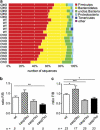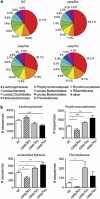Caspase deficiency alters the murine gut microbiome
- PMID: 22012254
- PMCID: PMC3219086
- DOI: 10.1038/cddis.2011.101
Caspase deficiency alters the murine gut microbiome
Abstract
Caspases are aspartate-specific cysteine proteases that have an essential role in apoptosis and inflammation, and contribute to the maintenance of homeostasis in the intestine. These facts, together with the knowledge that caspases are implicated in host-microbe crosstalk, prompted us to investigate the effect of caspase (Casp)1, -3 and -7 deficiency on the composition of the murine gut microbiota. We observed significant changes in the abundance of the Firmicutes and Bacteroidetes phyla, in particular the Lachnospiraceae, Porphyromonodaceae and Prevotellacea families, when comparing Casp-1, -7 and -3 knockout mice with wild-type mice. Our data point toward an intricate relationship between these caspases and the composition of the murine gut microflora.
Figures



Similar articles
-
Absence of the Caspases 1/11 Modulates Liver Global Lipid Profile and Gut Microbiota in High-Fat-Diet-Induced Obese Mice.Front Immunol. 2020 Jan 9;10:2926. doi: 10.3389/fimmu.2019.02926. eCollection 2019. Front Immunol. 2020. PMID: 31998283 Free PMC article.
-
Divinations and surprises: genetic analysis of caspase function in mice.Exp Cell Res. 2000 Apr 10;256(1):67-73. doi: 10.1006/excr.2000.4841. Exp Cell Res. 2000. PMID: 10739653 Review.
-
Roles of caspases in apoptosis, development, and cytokine maturation revealed by homozygous gene deficiencies.J Cell Sci. 2000 Mar;113 ( Pt 5):753-7. doi: 10.1242/jcs.113.5.753. J Cell Sci. 2000. PMID: 10671365 Review.
-
Impaired Autophagy in Intestinal Epithelial Cells Alters Gut Microbiota and Host Immune Responses.Appl Environ Microbiol. 2018 Aug 31;84(18):e00880-18. doi: 10.1128/AEM.00880-18. Print 2018 Sep 15. Appl Environ Microbiol. 2018. PMID: 30006408 Free PMC article.
-
Functional dynamics of bacterial species in the mouse gut microbiome revealed by metagenomic and metatranscriptomic analyses.PLoS One. 2020 Jan 24;15(1):e0227886. doi: 10.1371/journal.pone.0227886. eCollection 2020. PLoS One. 2020. PMID: 31978162 Free PMC article.
Cited by
-
Mice lacking Casp1, Ifngr and Nos2 genes exhibit altered depressive- and anxiety-like behaviour, and gut microbiome composition.Sci Rep. 2019 Apr 23;9(1):6456. doi: 10.1038/s41598-018-38055-8. Sci Rep. 2019. PMID: 31015500 Free PMC article.
-
Hybridization alters red deer gut microbiome and metabolites.Front Microbiol. 2024 May 3;15:1387957. doi: 10.3389/fmicb.2024.1387957. eCollection 2024. Front Microbiol. 2024. PMID: 38784815 Free PMC article.
-
Ecotoxicology inside the gut: impact of heavy metals on the mouse microbiome.BMC Pharmacol Toxicol. 2013 Dec 11;14:62. doi: 10.1186/2050-6511-14-62. BMC Pharmacol Toxicol. 2013. PMID: 24325943 Free PMC article.
-
Precise evaluation of the nutritional value of yeast culture and its effect on pigs fed low-protein diets.Anim Nutr. 2024 Aug 28;19:325-338. doi: 10.1016/j.aninu.2024.05.010. eCollection 2024 Dec. Anim Nutr. 2024. PMID: 39640552 Free PMC article.
-
Effects of different forms of amino acid supplementation on the performance and intestinal barrier function of laying hens fed a low-protein diet.Poult Sci. 2024 Dec;103(12):104375. doi: 10.1016/j.psj.2024.104375. Epub 2024 Oct 3. Poult Sci. 2024. PMID: 39442199 Free PMC article.
References
-
- Lamkanfi M, Festjens N, Declercq W, Vanden Berghe T, Vandenabeele P. Caspases in cell survival, proliferation and differentiation. Cell Death Differ. 2007;14:44–55. - PubMed
-
- Luthi AU, Cullen SP, McNeela EA, Duriez PJ, Afonina IS, Sheridan C, et al. Suppression of interleukin-33 bioactivity through proteolysis by apoptotic caspases. Immunity. 2009;31:84–98. - PubMed
-
- Kobori A, Yagi Y, Imaeda H, Ban H, Bamba S, Tsujikawa T, et al. Interleukin-33 expression is specifically enhanced in inflamed mucosa of ulcerative colitis. J Gastroenterol. 2010;45:999–1007. - PubMed
-
- Mitchell JA, Paul-Clark MJ, Clarke GW, McMaster SK, Cartwright N. Critical role of toll-like receptors and nucleotide oligomerisation domain in the regulation of health and disease. J Endocrinol. 2007;193:323–330. - PubMed
Publication types
MeSH terms
Substances
LinkOut - more resources
Full Text Sources

